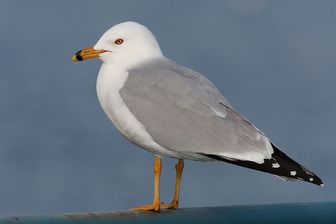Ring-billed Gull
Adults are 49 cm length and with a 124 cm wingspan. The head, neck and underparts are white; the relatively short bill is yellow with a dark ring; the back and wings are silver gray; and the legs are yellow. The eyes are yellow with red rims. This gull takes three years to reach its breeding plumage; its appearance changes with each fall moult.

Permission: GNU Free Documentation License
The Ring-billed Gull is classified as Least Concern. Does not qualify for a more at risk category. Widespread and abundant taxa are included in this category.
ring-billed gull is a common bird in parking lots, parks, beaches and other urban and suburban habitats. Despite not being a popular backyard bird, this gull is familiar to many birders. More
The Ring-billed Gull (Larus delawarensis) is a medium-sized gull. Adults are 49 cm (19 in) length and with a 124 cm (49 in) wingspan. The head, neck and underparts are white; the relatively short bill is yellow with a dark ring; the back and wings are silver gray; and the legs are yellow. The eyes are yellow with red rims. This gull takes three years to reach its breeding plumage; its appearance changes with each fall moult. More
The Ring-billed Gull breeds near lakes, rivers and the coastlines of Canada and the northern United States. Nests are built on the ground in colonies, and are typically used year after year. During the winter months, the Ring-billed Gull will migrate south to the Gulf of Mexico and the Atlantic and Pacific coasts of North America, as well as the Great Lakes. Some populations are also found in western Europe, Ireland and Great Britain. More
Ring-billed Gulls (Larus delawarensis) have the largest breeding populations of all the colonial nesting waterbirds on Lake Champlain. This medium sized gull nests on several islands in both Vermont and New York. The largest colonies are on Vermont's Young Island and New York's Four Brothers Islands. Other nesting islands include Popasquash, Rock (St. Albans), Rock (Panton), and Mud. The Ring-billed Gull was first documented nesting on Lake Champlain in 1949 with its numbers increasing dramatically during the 1970's. More
The Ring-billed Gull's range has expanded exponentially since the 1960s, and at various times it may be found anywhere in North America south of the boreal forests. These gulls breed across the middle section of North America, from coast to coast, with concentrations in northern California, the Great Plains, the Great Lakes, and the St. Lawrence Seaway. More
Ring-billed Gull Range MapView dynamic map of eBird sightings Field MarksHelp - * Adult breedingPopOutZoom In Adult breeding * © O.S. More
Ring-billed Gull Larus delawarensis = * Home Expand Log in Menu item Register Menu item Log out Menu item Change login details Menu item Why register? Expand UK & Ireland Menu item Birding sites More
Adult Ring-billed Gull in summer. More
The Ring-billed Gull is slightly larger and bulkier than the Mew Gull. The white body and tail, slate-gray back and wings, and black wingtips with large, white spots (windows), typical of most gulls, are all present on the Ring-billed Gull. The juvenile is mottled brown mixed with adult plumage characteristics. It has pink legs and a pink bill with a dark tip. As the bird matures, the legs turn yellow, and the bill becomes yellow with a black ring. More
Aspects of the topic ring-billed gull are discussed in the following additional content sources. * Magazines * AFTER WEST NILE VIRUS. Science News, March 29, 2003 Expand Your Research: Try searching magazines and ebooks for "ring-billed gull". No results found. - Type a word or double click on any word to see a definition from the Merriam-Webster Online Dictionary. More
The Ring-billed Gull was not to be persecuted for long. Protected in 1916 under the Migratory Birds Treaty between Canada and the United States, it staged a spectacular come-back, first slowly but later more rapidly. Today the ring-bill is the gull that most Canadians are likely to see, and the recent increase of its numbers has made this species a nuisance and management problem. More
The Ring-billed Gull is probably the most abundant gull in North America. More
Ring-billed Gull - Larus delawarensis = Characteristics Range Habitat Diet Life Cycle Behavior Classification Phylum: Chordata Class: Aves Order: Charadriiformes Family: Laridae Genus: Larus Ring-billed Gull Click on the images for a larger view. Characteristics Ring-billed GullThe ring-billed gull is a medium-sized gull. More
The Ring-billed Gull is a highly social bird. They occupy large colonies, especially during breeding season. They are a playful bird and can be seen dropping objects while flying just to swoop down and catch it again. They are also an opportunistic bird. They will steal food from other birds as well as unsuspecting beach goers. Don't confuse me with the Herring Gull. More
ring-billed gull population has been increasing steadily in recent history with the North American population estimated at 3-4 million. The breeding population in Chicago, discovered and estimated at less than 1000 individuals in 1975, has since grown to well over 100,000 individuals, and is continuing to increase at a rapid rate. Appearance: The ring-billed gull is a medium sized gull with a light gray back and upper wings, and white under parts and yellow legs. More

Original source: Diane Krauss (DianeAnna)
Author: Diane Krauss (DianeAnna)
Permission: Some rights reserved

